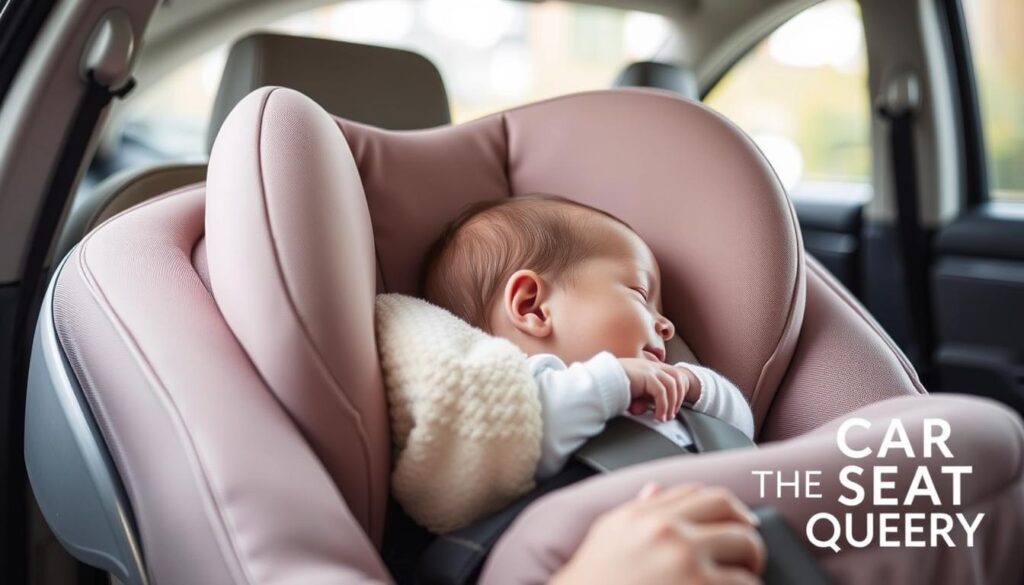What you must know about newborn head support in car seat

As a parent and certified child passenger safety technician, I’ve seen my fair share of questions and concerns when it comes to newborn head support in car seats. It’s a topic that often causes confusion and anxiety among new moms and dads, but fear not! In this article, I’ll share my expertise and personal experiences to help you navigate this important aspect of car seat safety with confidence.
From understanding the risks of aftermarket head supports to learning how to properly position your newborn’s head, we’ll cover all the essential information you need to keep your little one secure and comfortable during every car ride. By the end of this article, you’ll have a clear understanding of what you must know about newborn head support in car seats, empowering you to make informed decisions for your family’s safety.
What you must know about newborn head support in a car seat
Newborns have delicate bodies and larger heads in proportion to their size, which can lead to concerns about their head positioning during car rides. However, it’s important to understand that most infant car seats are designed to provide adequate support for your baby’s head without the need for extra inserts or cushions.In fact, many experts, including organizations like Safe in the Seat, advise against using aftermarket head supports. These additional products can inadvertently tilt your baby’s head forward, increasing the risk of positional asphyxia—a serious condition where the airway is compromised due to improper head positioning.
When Is Head Support Necessary?
The only time you should consider using head support is if your car seat manual explicitly states that it is required until your baby reaches a certain height or weight. If the manual indicates that head support is optional, it’s generally best to remove it. This allows your baby’s head to move naturally without the risk of being forced into an unsafe position
How To Support Newborn Head In Car Seat
Consult the Car Seat Manual
The car seat’s instruction manual is the most reliable source of information when it comes to approved accessories. Manufacturers provide specific guidelines and warnings about what can and cannot be used with their car seats. Look for sections that discuss approved accessories or modifications. If the accessory is not mentioned as approved, it’s best to avoid using it. Manufacturers design their car seats to meet safety standards, and using unapproved accessories can compromise the seat’s effectiveness in a crash.
Check for Manufacturer Approval
If the accessory is not included with the car seat, check if the manufacturer explicitly states that the accessory is safe for use with that specific model. Many manufacturers, like Britax and Chicco, clearly indicate in their manuals that only their own products or those explicitly approved by them should be used. This is because the car seat has been designed and tested with those specific accessories in mind. Using unapproved accessories, even if they seem similar, can alter the car seat’s performance and put your child at risk.
Look for Certification Labels
Approved accessories should have labels indicating compliance with safety standards, such as FMVSS 213. This certification means the product has been tested and meets federal safety requirements. Be cautious of products that claim to be “crash tested” without clear evidence of their compatibility with your car seat. Manufacturers will often include their own certification labels on approved accessories, making it easier to identify them.
Contact the Manufacturer
If you’re unsure about a specific accessory, reach out directly to the car seat manufacturer. They can provide definitive answers about whether an accessory is safe and approved for use with your car seat model. Manufacturers have the most up-to-date information on approved accessories and can guide you on the safest options for your specific car seat.
Consult a Child Passenger Safety Technician (CPST)
For personalized guidance, consider consulting a CPST. These professionals are trained to help you understand car seat safety and can advise you on approved accessories. They have extensive knowledge of car seat safety standards and can help you navigate the sometimes confusing world of car seat accessories. CPSTs can also help ensure that your car seat is properly installed and your child is correctly harnessed, further enhancing their safety.
Avoid Aftermarket Products
As a general rule, avoid using aftermarket accessories that are not specifically designed for your car seat. These products often lack the necessary safety testing and can compromise the effectiveness of the car seat in a crash. Manufacturers design their car seats to meet strict safety standards, and using unapproved accessories can alter the seat’s performance in unpredictable ways. It’s simply not worth the risk to your child’s safety.
Safe in the Seat
Positioning Your Newborn for Optimal Head Support
It’s important to make sure your newborn’s head is well-positioned and supported in the car seat. This keeps them safe and comfortable. By following a few simple steps, you can give your little one the support they need during car rides.
Adjusting the Harness and Straps
Start by adjusting the car seat harness and straps to fit your newborn well. The harness should sit at or below your baby’s shoulders. The straps should be tight enough to keep them in place without being too tight. Check the fit often and adjust as your newborn grows.
Proper Recline Angle
The recline angle of the car seat is key for your newborn’s head support. The seat should be tilted between 30 and 45 degrees. This stops your baby’s head from falling forward or to the side. Always check your car seat’s manual for the right recline angle.
By following these tips for positioning your newborn and adjusting the car seat, you ensure your little one’s head is secure and supported. Remember, your child’s safety and comfort are the most important things.
Preventing Flat Head Syndrome
Newborns’ skulls are delicate and can easily develop flat head syndrome, also known as positional plagiocephaly. This happens when a baby’s head is pressed against a surface for too long, causing it to flatten on one side. It’s important for parents to know how to support their baby’s head in the car seat and during daily activities.
Understanding Positional Plagiocephaly
Up to 50% of newborns get positional plagiocephaly. It often happens when a baby lies on their back too much, like in a car seat, stroller, or crib. This pressure can make the skull flatten and become uneven.
This condition isn’t serious and doesn’t affect brain development. But, if not treated, it can make the head look misshapen permanently.
Fortunately, parents can prevent and manage flathead syndrome in their babies.
Preventing Flat Head Syndrome
- Ensure proper head support in the car seat: Use the car seat’s built-in head support features or add a small, firm pillow to keep your baby’s head in a neutral position.
- Encourage tummy time: Regularly place your baby on their stomach while awake and supervised to prevent prolonged pressure on the back of the head.
- Alternate the sleeping position: Gently turn your baby’s head to the opposite side each time you place them down to sleep, encouraging even head shape development.
- Limit time spent in stationary devices: Minimize the amount of time your baby spends in car seats, strollers, and other devices that restrict head movement.
- Consult a pediatrician: If you notice any concerns about your baby’s head shape, don’t hesitate to speak with your healthcare provider, who can provide guidance and recommend treatment options if necessary.
Developmental Milestones and Head Control

As your newborn grows, they will get better at controlling their head and neck. It’s important to know about the usual steps they’ll take in this area. This knowledge helps keep your baby safe and comfortable in the car seat.
At first, newborns can’t control their heads well, which makes them prone to head flops or bobbing. That’s why it’s key to have the right head support in the car seat during these early days. As your baby gets stronger, they’ll start to control their head better.
By 3-4 months, most babies can keep their head steady with support. By 6 months, they can hold their head up by themselves for a bit. This change affects how you should position and support your baby in the car seat as they grow.
Keep an eye on your child’s progress and adjust the car seat as needed. Having the right head support is vital for safety and makes car rides more comfortable for your baby.

Conclusion
Whew! We’ve covered a lot of ground on newborn head support in car seats. Remember, your baby’s safety is paramount. By following the tips in this article, you can create a safe and comfortable environment for your little one during every car ride.
Here’s a quick recap:
- Skip the aftermarket head supports – most car seats provide adequate support already.
- Always refer to your car seat manual for approved accessories.
- Proper positioning and harness adjustment are key for optimal head support.
- Tummy time and alternating sleeping positions help prevent flat head syndrome.
- Monitor your baby’s development and adjust the car seat as needed.
Now, you have the knowledge and confidence to ensure your precious cargo travels safely and soundly. Happy and safe travels to you and your little one!
